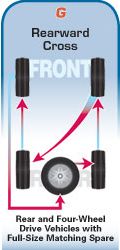OK, it might be time for my lecture on tire rotations.
If the front and rears of vehicle did the same thing, then there would be no need to rotate tires. Unfortunately, that is not the case.
Steer tires tend to wear in the shoulders and drive tires tend to wear in the center. RWD cars (and trucks) have about the same wear rate front to rear, but FWD tends to wear much more rapidly on the front.
HOWEVER, the type of driving that is done can affect the wear rate, front to rear. Driving in a straight line (think country driving) tends to wear the drive tires faster than the steer tires, but the overall wear rate is lower. But it also affects the wear pattern as country driving has less turns, so the steer tires don't wear the shoulders as fast.
So on RWD, country driving is good for the overall wear rate, but the rear tires will wear out first. The opposite is true for RWD city driving - the steers will wear out first and the overall wear rate is faster.
On FWD/country driving, the front tires will tend to wear slower, but in the center, where city driving causes more rapid and shoulder wear.
So what about the rears on a FWD? They tend to wear very slowly. I've calculated the difference to be about 2 1/2. So a set of tires where the fronts wear out in 20,000 miles, the rears will go about 50,000 miles.
And rears on a FWD are more affected by alignment conditions than the fronts - however, those affects show up much more slowly than the fronts.
My experience says that at about 20K, a FWD with no tire rotation will start to show some irregular wear. It will start out as noise, and gradually get worse until it is a vibration. When it starts and how quickly it develops is highly dependent on how bad the alignment is - and by how bad, I don't mean how far off the specs. I mean how much absolute toe and how much absolute camber (meaning, the published alignment specs aren't always the best for tire wear. They are sometimes for best handling.)
So the whole idea behind rotating tires is to even out both the wear rate and the wear pattern. - and in particular, to slow down the appearance of irregular wear, which is largely not reversible. I don't think there is such a thing as too much tire rotation (except to say the cost and labor issue) - but the opposite is not true.
So what about front to rear rotation vs cross rotation?
In the old days, the standard tire rotation pattern was a modified X - drives on the same side, steers cross (Remember, this was the days of where pretty much every car was a RWD and tires were bias ply!)
Just about the time FWD started being introduced was about the time radials started to be introduced - and there were problems with the belts on early radials. A common recommendation was to keep the tires from reversing rotation direction to reduce the possibility of a failure. I don't think that actually worked in practice, but the industry adopted it anyway.
Once the belt problem was solved, the tire industry gradually reverted back to the modified X tire rotation pattern - but for some reason, the car manufacturers didn't update their owners manuals.
It seems that car manufacturers really don't pay much attention to the manuals as there are all kinds of things in there that are way, way obsolete (like references to bias ply tires) and things that ought to be there that aren't (like replacing all 4 tires on a AWD!) - and those are just the tire related stuff. I wonder about some of those other things that I am not knowledgeable about!
So there you have it. I recommend regular tire rotation - even though it disguises alignment issues. (If you really pay attention, you can diagnose alignment issues AND rotate tires).


